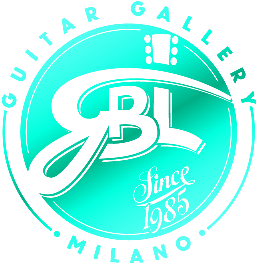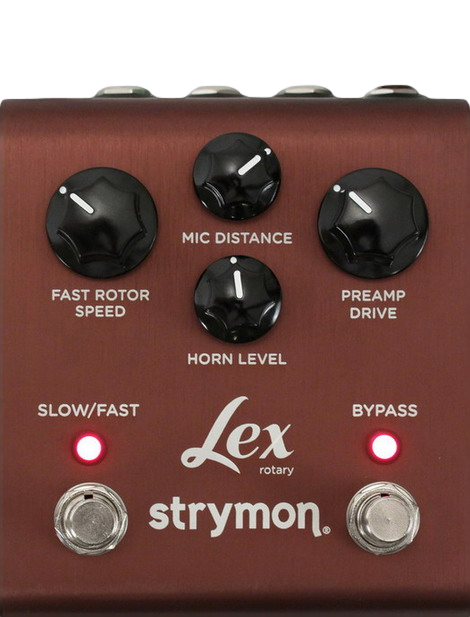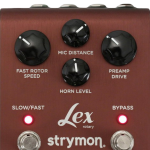Lex now includes a selectable TRS stereo input as well as non-click footswitches. Read more here.
Read the Rotary Speaker Technology white paper and learn how we studied and captured every rotating speaker system detail.
“The Lex nails a host of rotary speaker tone, but it also delivers a lot of the response and feel of playing one in impressive fashion.” – Premier Guitar
“The Lex is fun, and it sounds brilliant” – Total Guitar


Sound Clips
Below are sound clips played by our resident Sound Designer, Pete Celi. Signal path: Damage Control Demonizer » Lex » PC audio interface.
With the Mic Distance at maximum, the amplitude modulations are mellowed out. Adding a little more horn signal adds emphasis on the doppler reflections. The speed is varied to get the sense of the mechanical aspect that controls the motion.
This clips starts with the brake engaged, and then releases and re-engages the brake to show how naturally the system starts and stops. The system comes to rest at a ‘zero degrees’ angle for consistent and sonically optimum results.
Bringing the mic up close creates a high amplitude modulated signal from the horn. Rich, fat harmonics are created by moderately overdriving the preamp with the Preamp Drive control.
A jangly strat gets fattened up by driving the preamp and reducing the Horn Level slightly. Slow speed and medium Mic Distance settings combine to create a classic sound for ballads.
Maximum preamp drive with close-up miking creates heavy harmonic content with lots of amplitude modulation. A big stereo spread when spinning slowly, and a choppy tremolo-like effect at fast speeds.
Increasing the Horn Level adds emphasis on the high end. Minimum preamp drive creates a clean signal to get worked on by the rotating machinery.
Distant miking with added Horn Level creates a nice watery effect. Minimum preamp drive keeps things clean.
Close miking with moderate Drive followed by maximum Drive. The growl is present along with the dramatic stereo sweep in slow speed and ‘choppy’ horn character at fast speed.
Mic is moved back a little, minimum Preamp Drive for a clean classic rotary suitable for comping and grooving.
The Mic is moved from up close to further back, and then even further away to demonstrate it’s ‘mellowing’ effect as it moves away from the rotary speaker.
A simple progression with a classic rotary sound.
Here are some sound clips played by Strymon’s marketing guy Ethan Tufts (AKA indie artist State Shirt). Signal path: Damage Control Womanizer » Lex » Digi002 audio interface.
Fast Rotor Speed is set to 9:00 for a medium rotational speed. Preamp Drive is reduced for a mellower and less growly tone. Horn Level is at a lower level for evened-out fluctuations. Slow/Fast switch is pressed at the :15 mark to slow the machine down. Slow/Fast is pressed again :23 to speed up the machine.
A moderate amount of Preamp Drive is employed here for a more tube-driven tone. Slow/Fast switch is pressed at various times to slow down and speed up the system.
Preamp Drive is set to just above half to introduce in a good amount of tube drive and saturation. Horn Level is set in the middle for an evened-out sound.
Acceleration Time is set to the fastest setting for a rotating speaker system that quickly switches from fast speed to slow and back. The Slow/Fast switch is pressed at various times to generate complex rotary sounds that occur when the system is in transition between speeds.
Born to Revolve.
When we decided to create a studio-class pedal that faithfully recreates the classic, unmistakable sound of the most sought-after rotating speaker system, we prepared to study every nuance and finest detail. The Strymon sound design labs have been filled with those signature, swirling, three-dimensional sounds, as we painstakingly analyzed and recreated the physics and mechanics behind these systems.
Lex provides you with a complete, accurately reproduced rotary system: the low-frequency bass rotor, the rotating treble horn, the tube-driven amplifier, finely tuned microphone placement, and all the complex sonic interactions between these elements. Utilizing a ridiculously powerful SHARC DSP, every drop of processing power is harnessed to authentically represent these details.
You get eight parameters to tweak, allowing extensive control over the tonality and mechanics of the rotating speaker system. You can manipulate each element, from rotor speed, horn level, acceleration time, microphone distance, tube drive and saturation, and volume level. Go from a maelstrom of dramatic, up-close, sweeping and swirling sounds, all the way to mellow, tranquil and calming undulations. All of this without a giant cabinet, microphone setup, and costly motor maintenance.
Rotary Adjustment and Tone Shaping
Four rotary adjustment and tone shaping knobs: Fast Rotor Speed, Preamp Drive, Mic Distance, Horn Level.
Four “hidden” knobs for extensive tweaking: Slow Rotor Speed, Cab Direction, Acceleration Time, +/- 6dB Boost/Cut.Your 4-knob Lex Rotary is actually a 8-knob rotating speaker machine!
FAST SLOW SWITCH
 |
Alternate between a fast and slow rotor speed. Ramp up and slow down with the press of a switch. |
ROTARY BRAKE
 |
Press and hold the Fast/Slow switch to put the brakes on. The Lex rotary will wind down and stop. When at rest, the horn and drum “brake angle” is optimally positioned for consistent results. Release the Fast/Slow switch and the rotary will begin to spin. |
BI AMPING
 |
Lex provides you with a selectable Bi-Amp mode to send bass rotor signal out to the Left output, and the treble horn to the Right output. Stack two cabinets and add another dimension to your sound. |
EXPRESSION PEDAL
 |
You get an expression pedal input with assignable control over any front-panel knob parameter. When set to Fast Rotor Speed, you can sweep and ramp all the way from the “braked” position up to a selectable speed. |
What’s Happening Inside?
Lex rotary delivers a faithful reproduction of the entire rotating speaker system. It’s all here—the low-frequency bass rotor, the rotating treble horn, the tube-driven amplifier, finely tuned microphone placement, and all the complex sonic interactions between these elements. Read our Rotary Speaker Technology white paper to learn more.
SOUND DESIGN
- Hand crafted rotary algorithms faithfully deliver the signature, three-dimensional rotating speaker experience
- Extensive control over rotating speaker mechanics and configuration
- Four rotary adjustment and tone shaping knobs:
Fast Rotor Speed, Preamp Drive, Mic Distance, Horn Level. - Four “hidden” knobs for extensive tone tweaking:
Slow Rotor Speed, Cab Direction, Acceleration Time, +/- 6dB Boost/Cut. - Instantly alternate between a fast and slow rotor speed with the Fast/Slow footswitch
- Selectable Cab Filter allows for an optimal experience in front of guitar amplifiers and full range systems
INS,OUT,SWITCHING
- Stereo output
- High impedance mono input (internal jumper enables selectable TRS stereo input) Pleaseread this FAQ for more info on the TRS input.
- Expression pedal input with selectable control over any knob parameter
- Connect our optional Favorite switch to save a favorite preset or use as an external speed switch
- Fast/Slow and Bypass footswitches
- Press and hold Fast/Slow footswitch for Rotary Brake
- Selectable Bi-Amp mode splits bass rotor and treble horn signals to separate outputs
AUDIO QUALITY
- Ultra low noise, high performance 24-bit 96kHz A/D and D/A converters
- 110dB typical signal to noise
- Premium analog front end and output section
- Super high performance DSP in a compact form factor
- 32-bit floating point processing
MORE
- True Bypass (electromechanical relay switching)
- Powered with a standard 9V center negative DC supply. 250mA minimum
- Strong and lightweight mahogany anodized aluminum chassis
- Crafted with love in the USA
Video Demos








Be the first to review “STRYMON LEX ROTARY SPEAKER”
Devi essere connesso per inviare un commento.